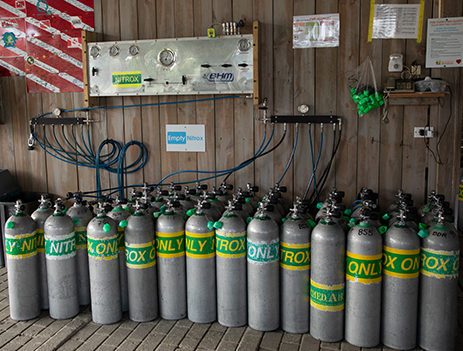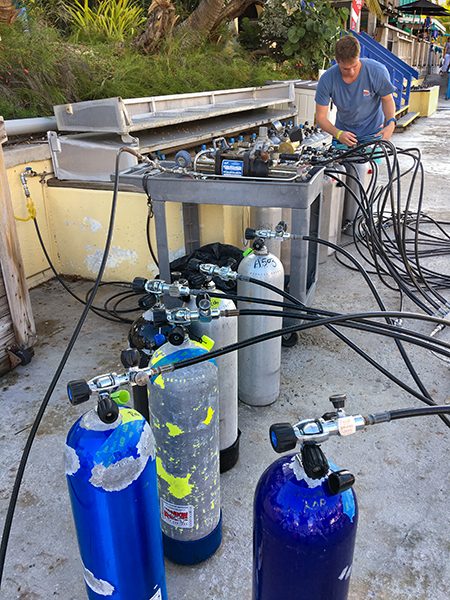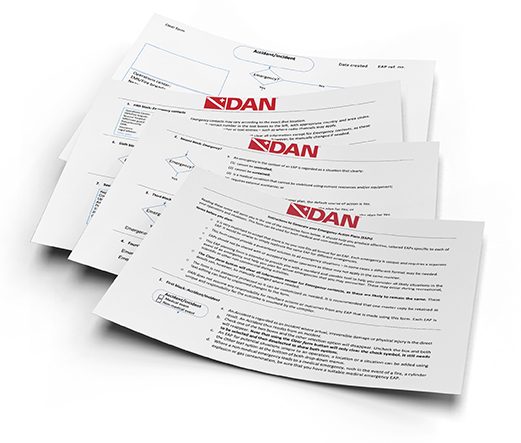COMPRESSOR ROOM
AND FILL STATION SAFETY

IF NOT PROPERLY SET UP AND MAINTAINED, compressor rooms and fill stations can be among the most hazardous areas of a dive business. Determine how safe your compressors and fill stations really are by conducting a dedicated risk assessment of your facility. A single high-level walk-through of the rooms that house your compressors and associated equipment can clue you in to a variety of hazards that you can address — before they cause a devastating accident.
COMPRESSOR ROOM
There are quite a few safety considerations to keep in mind when assessing a compressor. Contamination can come from many different sources, including exhaust from a nearby boat or parking lot, smoke from cigarettes or cooking, cleaning products, and other volatile chemicals and generators. To prevent air contamination, be sure your compressor’s air intake is positioned far away from potential sources of contamination. Consider posting a sign near the air intake prohibiting running motors, smoking, etc. nearby. Better yet, complement the sign by installing a physical barrier, or move the intake so it is out of reach of any of these sources of harm.
In addition to taking steps to prevent contamination, use logs and checklists on the compressor to track and ensure essential functions, and reliability. In addition to logging information about each fill, log the date and type of service performed on the compressor, the reason for the service, actions taken, parts replaced, the name of the technician, and the date of the next planned service.
FILL STATION
Most dive shops have unique fill station configurations that reflect their business and customer demands. This means that there is no single correct way to set up your fill station; rather, there are guidelines that must be followed. The most important of these is probably that your fill station be inaccessible to anyone but trained employees. Fill stations are potentially dangerous spaces in which hazardous work takes place; they are not suitable for heavy traffic or socializing.
Once you have ensured restricted access to your fill station, make sure you have set fill procedures that all employees are required to follow. These procedures may address inspection of customers’ cylinders prior to filling, safe fill rates, coupling and uncoupling, cylinder thread types, knowledge of maximum pressure ratings for cylinders, oxygen analysis, and record keeping. Create separate procedures for each type of mixed gas your operation offers.

HIGH-PRESSURE HOSES
High-pressure hoses used to fill cylinders can be dangerous given the right circumstances, so these should be assessed on a regular basis. Hoses should be as short as practically possible; the longer the hose, the greater risk of damage caused by a loose fill whip in the event of a failure. Wherever possible, consider using rigid piping to reduce the length of flexible hoses.
All high-pressure hoses should be fitted with whip restraints to prevent any hose from whipping if it becomes separated from its end-fitting. These can cause serious and even fatal accidents. Assess the condition of all flexible hoses on a regular schedule, and consider replacing any hoses that are used daily every five years.
EMERGENCY ACTION PLANS
In addition to covering your response to dive accidents, your emergency action plans (EAPs) should also address problems that may arise in the fill station or compressor room. If you don’t already have EAPs for your fill station or compressor room, draft them. Effective EAPs for these areas should include, at a minimum, procedures for responding to contaminated breathing gas, high-pressure component rupture (fill whip, cylinder, etc.), fire, and injury. Compile or review your EAPs, and consider doing high-level walk-throughs or simulations for each potential emergency
As you conduct your risk assessment, bear in mind that not all risks carry the same weight. Prioritize areas in which exposure is regular and in which the consequences of an accident would be significant. Remember, even a cursory inspection of rooms that house bank and cascade systems, chemicals, or spare parts can alert you of numerous potential hazards. Taking just a few hours to assess these areas and use what you observe to refine the safety of your operation can prevent serious accidents.

DAN Customer Service
Mon–Fri, 8:30 a.m. – 5 p.m. ET
+1 (919) 684-2948
+1 (800) 446-2671
Fax: +1 (919) 490-6630
24/7 Emergency Hotline
In event of a dive accident or injury, call local EMS first, then call DAN.
24/7 Emergency Hotline:
+1 (919) 684-9111
(Collect calls accepted)
DAN must arrange transportation for covered emergency medical evacuation fees to be paid.
Medical Information Line
Get answers to your nonemergency health and diving questions.
Mon–Fri, 8:30 a.m. – 5 p.m. ET
+1 (919) 684-2948, Option 4
Online: Ask A Medic
(Allow 24-48 hours for a response.)
